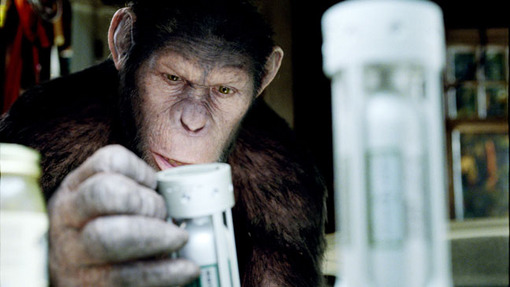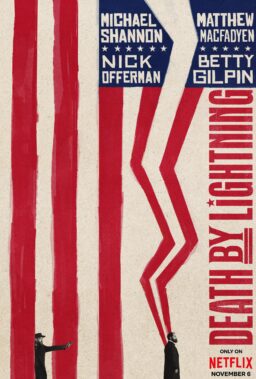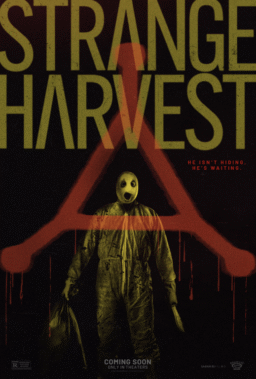A horror or science-fiction movie without subtext is like Dr. Frankenstein’s laboratory without electricity. The inner metaphor is what gives it life and resonance. Otherwise, it’s just a story about stitched-together people parts. Or take David Cronenberg’s “The Fly,” a riveting, poignant horror/science-fiction/romance about an ambitious scientist who accidentally gets his DNA mixed up with that of a housefly. Everything about the movie is first-rate, from the direction to the performances to the effects. But what really grabs hold of you is the universal theme: We are all Brundlefly, sentient, self-aware beings whose bodies are going to decay and die. In 1986, a lot of people assumed the subtext was AIDS; Cronenberg later said he was thinking in more general terms about the process of aging. It doesn’t matter. The movie works on those levels.
Cronenberg is particularly ingenious at making the word flesh, and the ways he develops his ideas are often even scarier than the explicit horrors: “The Brood” is a masterpiece about the psychosomatic effects of rage turned inward, and about the legacy of emotional abuse passed down from one generation to the next; “Videodrome” is about technology as an extension of the body and the brain; “Dead Ringers” is about mutant forms of psychological and sexual intimacy; “Naked Lunch” is about a writer who has to internalize his own sexuality before he can create art…. Cronenberg is an organic, visionary thinker, storyteller, filmmaker. His movies have meat on their bones. Other filmmakers whose work strikes me as insubstantial lack this ability to flesh-out their pictures with compelling, animating ideas. Their plots are meticulously plotted, but they’re skin-deep and there’s nothing to sink your imaginative teeth into.
Which brings me to this summer’s hits, “Transformers: Dark of the Moon” and “Rise of the Planet of the Apes,” neither of which I have much interest in seeing. Instead I’m intrigued by a few things I’ve read about them — specifically about their subtext, or lack thereof. In a piece about the racial themes of “The Help” (“Why Can’t Critics Just Get Along?“), David Poland writes:
It is not really a stretch to see “Transformers: Dark of the Moon” as a film that lingers in the subtext of race, WWII-inspired action-dramas, and especially the films where a small band of scary men come together to protect a native village from some other form of greater organized terror. But many critics simply refuse to see that film as anything more than cynical money-grabbing ugly clanging metal not worth actually thinking about.
In 1968, critics made much of “The Planet of the Apes” as a racial allegory. It was 1968, after all, and as I never tire of saying: movies are not made or seen in a vacuum. In 1999, Eric Greene published a study of the initial five-film “Apes” series called “‘Planet of the Apes’ as American Myth: Race, Politics, and Popular Culture.” The publisher noted:
The Apes films confronted some of the most controversial issues of the time, including Vietnam and the Black Power movement, all the while remaining crowd pleasing box office hits.
Eric Greene uses rare photographs, transcripts, and extensive interviews with the writers, directors, actors, and producers to read the Apes saga as a profoundly American myth. Greene also looks at the attempts of filmmakers like Oliver Stone and James Cameron to remake the myth for the 90s. This enjoyable and meticulous book gives the reader an insider’s look at the complex relationships between race, politics and popular culture in America.
In his review of the 2011 prequel, “Rise of the Planet of the Apes,” Ed Gonzalez at Slant Magazine writes:
Franklin J. Schaffner’s 1968 sci-fi classic was an audaciously pulpy, uniquely Serling-esque allegory for racial relations in Civil Rights-era America in which the historical relationship between whites and blacks was reversed. That sly allegory was hatefully perverted by white supremacists, even deemed derogatory by some in the Black Power movement, but its provocation is unmistakable as one directed against the forces of institutionalized racism. “Rise of the Planet of the Apes”‘s only provocation is that it would appear to buy into the myth of a post-racial America. Rather than hold a mirror up to a country’s racial hostilities, it capitulates to Hollywood formula and political correctness; save for a tacky scene during which a scrawny white goon at an animal compound turns a fire hose on the uppity Caesar (a handsomely motion-captured and best-in-show Andy Serkis), it only has the best interests of PETA, not the NAACP, in mind.
Over at GreenCine, Vadim Rizov sees the new “Planet of the Apes” movie as thematically hollow:
“Rise” decides it doesn’t really need resonance or grown-up subtext. It has something better: digitally rendered monkeys that can move really fast. When the chimps make a run for the woods, they move at velociraptor speed. The ’60s and ’70s didn’t have such technology and relied on profundity, but “Rise” doesn’t need ideas.
So, the questions arise: If a movie contains any subtext at all (whether compelling or coherent is another matter), what is it working through and how does it operate? Zach Campbell at Elusive Lucidity coined the term “Diffuse Cinema” for films that are often described by critics with lists of diverse thematic elements. By way of example, he quotes a review of last year’s “Splice” by Kim Dot Dammit: “the film manages to combine a whole mess of hot topics such as abortion, biotechnology, the reproductive industry, genetic research, cloning, big pharma’s role in late capitalism, maternity, sexuality/gender and so much more into one disturbingly effective film.”
“A while back,” he writes, “I gave a conference paper on ‘reversible films, blockbuster cinema that seeks to accommodate politicized readings by accommodating even contradictory ideologies.”
On a textual level, there is no true interpretation to movies like “The Lord of the Rings” or “The Matrix” or even more ostensibly right- and left-wing “300” (2006) and “V for Vendetta.” These films have fluid, if not gaseous, rules for the construction of their allies, enemies, and causes. Their engineering as narrative packages is highly clever and streamlined. In a related way but on a more sophisticated level is another articulation of cinema, what we might call ‘diffuse.’ The difference — and of course I’m speaking impressionistically and in generalities, and any given film will offer particularities which trouble my categories — is that a reversible film fosters a political position (any number of positions), a spiritual forebear being something like “Invasion of the Body Snatchers,” whereas the diffuse film knowingly revels in the messiness, in the feeling of impossibility of a clear political through-line. It goes into the cul-de-sac, it embraces the ethical, epistemological, sociopolitical clusterf**k. But diffuse cinema, like “Splice” or “District 9” (Neill Blomkamp) or some Arnaud Desplechin, seems to me to deliberately inspire such lists of diverse topical or thematic content as those highlighted above. When the film in question is considered effective, the iteration of such lists is meant to indicate that these nodes are mobilized in rich, weird, perhaps unpredicted or unpredictable, and sophisticated ways.
At my old Jeeem’s CinePad site (consistently never updated since 1998!), I have a section called The Big Lie, featuring reviews of popular movies that claim to be about one set of values on the surface, but fatally undermine those ostensible values with (“Pretty Woman,” “Mississippi Burning,” “Dead Poets Society,” “Thelma and Louise,” “Natural Born Killers“). The matter of their “messages” collides with the anti-matter of their cinematic techniques and… poof. From the introduction:
In movies, style is content. But what a movie says and what it does aren’t necessarily consistent or compatible. Sometimes those contradictions are part of a deliberate strategy to provoke or unsettle you. Sometimes they’re just signs of the filmmakers’ incompetence. And sometimes they tell… The Big Lie.
The movies below are fascinating to me because, like a bad con artist who can’t look you in the eye, they make claims that are undermined and contradicted by their own cinematic “body language.”
The movies I examine in this Big Lie section are at war with themselves in ways that are both appalling and irresistibly fascinating. It’s not that they’re hodge-podges of fragmentary notions and topics, or that they have nothing going on beneath their plot/character surfaces, but that they exhibit such cinematic cognitive dissonance they implode as you watch them. If you watch them. These movies were mainstream popular hits and few questioned that they were what they said they were — that “Pretty Woman” was a romantic Cinderella story, “Mississippi Burning” a civil rights melodrama about how J. Edgar Hoover’s nice FBI men helped out those poor Negroes down south, “Dead Poets Society” a celebration of nonconformism, “Thelma and Louise” a feminist fable, “Natural Born Killers” another rebel-couple-on-the-run tale… (See my reviews for what I think these movies are really up to.)
I wonder if Clint Eastwood’s “Million Dollar Baby” (a peculiar title for this story if you think about it) would have become an Oscar-winning hit if audiences saw it the way Carloss James Chamberlin did in a senses of cinema essay called “The Magic of Risking Everything For a Dream Nobody Sees: ‘Million Dollar Baby’: The Shadow Film.” I’ve always been disconcerted by aspects of the movie that don’t make much sense in terms of story and character — especially the final revelation that Scrap Dupree’s (Morgan Freeman) narration has been in the form of a letter to Frankie Dunn’s (Eastwood) estranged daughter. Chamberlin re-examines the entire movie as a Jungian psychodrama in which Frankie acts out his rage toward his real daughter by loving, punishing, crippling and murdering her surrogate, Maggie (Hilary Swank):
Murder, then, but as therapy. In psychological terms, “Million Dollar Baby” is a myth of rebirth. What Frankie has done is projected his lost daughter onto the tabula rasa that was Maggie, and made her a totem for his real one, exploited her, and even loved her successfully, according to his terms, and then killed her off, which pays unexpected and significant benefits in the matter of his conscience. Killing Maggie allows him to evade the trap set by his “bad” conscience. Non Habeas Corpus. Scrap [the embodiment of Frankie’s conscience] bears witness, but will never have the opportunity to reproach.
Maybe I’m stretching things a little, but in this reading “Million Dollar Baby” becomes a kind of horror film along the thematic lines of “The Shining” or “The Stepfather,” in which Frankie invests his rage over his family and career disappointments — and his thwarted love — in a Million Dollar Baby (his shot at redemption), whom he creates himself (see “Frankenstein,” “Splice”) and when she lets him down by getting severely injured, becoming another burden, he kills her and walks away. Which is one hell of a subtext.
I maintain that movies are, primarily, metaphors and if all they’re doing is laying out a plot that takes the characters from A to B to C (even if the chronology is cleverly scrambled) then there’s not much to engage the imagination. A story doesn’t require complexity, but it needs depth to resonate.
How important is “subtext” to you? (Sorry, I actually hate that word — it sounds like my elementary school teachers telling us to “read between the lines.”) Is a ripping yarn good enough?











